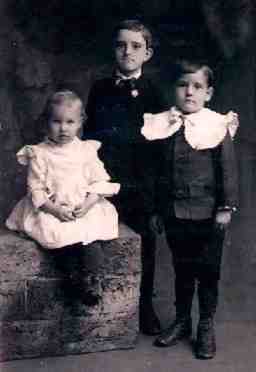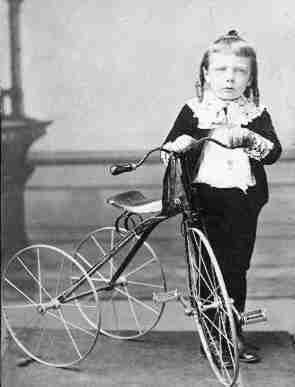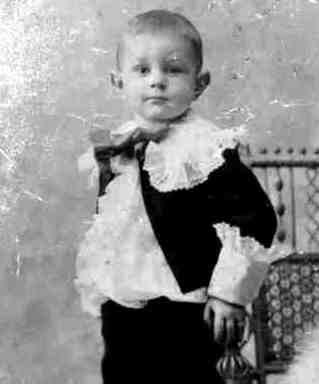
Figure 1.--This boys wears a huge collar in a photograph taken in the 1890s. Notice the adult looking suit worn by his older brother. Lace collars could be quite expensive. A less expensive alternative for a boy was a ruffled collar.

Lace collars came in a wide variety of types and sizes. The one constant was that they were all white. Many of the available images unfortunaely are not clear enough to fully access the collars pictured.
Some of the largest collars extending to and over the shoulders were part of the blouse. Some of the collars were all one material. Some colars were a combination of different materials. Often they had ruffles and lace trim along the outer edge. The trim on the outer edge of some collars, especilly the larger ones that extended to the shoulders were sometimes made to stand up perkily.
The classic Fauntleroy suit was worn with a blouse with a large lace collar. The collar varied in size, but was part of the blouse. The collar was in some cases so large that it extended to, and in some
cases, beyond the shoulders. The all lace collars were generally the smaller ones, while the collars with added ruffles were the lager ones extending to the shoulders.
The blouse was a critical element of the Fauntleroy suit. In fact, it was so important that the Fauntleroy jacket was designed to be worn open so
that the blouse could be seen. The blouse itself often had lace and ruffle trim viricaly along the button line and at the wrist. The Fauntleroy blouses were always long sleeved. The wrist trim could, like the
collar be quite large, extending in some cases nearly to the elbow.
Some lace collars were not part of a blouse, but rather sewn on to the dress, jacket, or coat. These collars were most commonly worn with Faunteroy jackets that were not styled to be worn open. The classic Fautleroy coat was very small, meant to be worn open with a fancy blouse with copious ruffles and lace trim. Some of these suits had matching wrist trim, but many did not. The attached lace collar was normally relatively small. It appears to have been a less costly alternative to an expensive Fauntleroy blouse.

Figure 2.--This boy wears an all lace collar and matching wrist trim. Note the ringlet curls and hair top knot. |
Some lace collars were entirely made of lace. These all lave collars
came in many different sizes, shapes, and lace designs.
Size: Lace was quite expensive.
Thus the cost of the lace might limit the size of the collar. Thus the
all lace collars, while often substantial, were not the largest of the
collars worn during the Fauntleroy craze of the late 19th Century.
Shape: Lace collars came in a wide variety of shapes. Many of these collars were rounded, but others had geometric designs such as star points. Others had a generally rounded collar with only small points of the lace adding a slightly jagged
edging to the collar. Variations in the sizes of the collars added increased variety to the various basic shapes.
Lace design: Lace collars were made from a wide variety of lace types and designs. Unfortunately the available photographs often do not have high enough resolution to assess the actual design in
the lace itself.
Another variable for the all lace collars was wether the collar
lace was repeated in the sleeve wrist trim. It it was repeated, the
trim could vary in size and desisn.

Figure 3.--Not all boys in Fauntleroy suits had ringlet curls. This boys collar had velvet at the edges of the collar and wrist trim. |
Many collars consisted of mixed materials. In many cases the actual lace could be a small part of the collar. This was even true for large collars.
Often there was lace with added ruffles designed to make the collar. The ruffles could be added as edging to the lace collar. In some cases lace ruffles could be added to a solid white collae.
After the turn of the 20th Century, Fauntleroy suits were increasingly worn with ruffled, rather than lace collars. I am not sure what caused this c
change in fashion, but it is very pronounced. The Fauntleroy collars, of course, were not the first ruffled cllars to be worn by boys. Ruffled
collars were very commony in the early 19th century for boys with both tunics and skeleton suits. Their popularity wained in the 1880s as lace collars were generally worn with Fauntleroy suits. After the turn of
the century, Fauuntleroy suits continued to be worn until the early 1920s, but increasingly with ruffled rather than lace collars. Since the 1920s, boys have no longer worn ruffled collars, except for special costumes like wedding ring bearers or coral performances.
Some of the ruffled collars, especially the larger ones extending to the shoulders had ruffles which stood up perkily. The part that stood up was the ruffles at the very edge of the collar.
Collar bows, like the collars thenselves, varied grearlt. Some were small and were almost lost with an enormous collar. Some collars were worn
with no bows at all. Some bows competed in size with the collars. The bosw also varied in color. Some were white. Others were a variety of colors
and patterns designed to contrast with the white collar.
Navigate the Boys' Historical Clothing Web Site:
[Return to the Main lace collar page]
[Introduction]
[Chronology]
[Clothing styles]
[Biographies]
[Bibliographies]
[Contributions]
[Countries]
[FAQs]
[Boys' Clothing Home]
